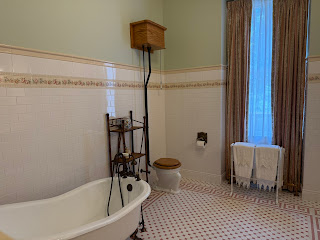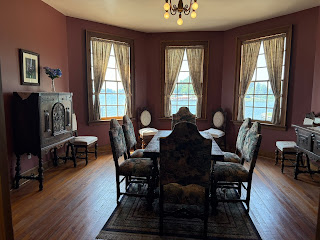While researching things to do near Perth, Ontario, Boldt Castle popped up on my list. Other places closer to Perth also appeared on the list, including the Perth Museum and the Mammoth Cheese (a replica of the 22,000 pound cheese forefathers made in 1893 to send in to the Chicago World's Fair), but I was looking for a destination for a day.
When I mentioned Boldt Castle to Don his first reaction was "didn't we go there already?" I turned to this blog to settle the fight. In 2014 (eleven years ago) "we missed the ferry by five minutes and the next one would only allow us an hour on the island." With that settled, we planned to spend Monday on Heart Island.
Even if we had visited in 2014 so many changes have taken place to Boldt Castle and its grounds it would have been worthy of a second visit. The Butlers' Pantry and Maids' Dining Room opened in 2014. The kitchen renovations were completed in 2015, as were the servant's dining room, and Italian Gardens. Craftsmen continue to work on the castle.
The castle is only open in the nicer weather months, which makes sense because the only way to access Heart Island is via boat.
I researched how to get to Boldt Castle. It sits in the 1000 Islands region between New York State and Canada, on the US side. We were already in Canada, so it made sense to enter from the Canadian side. The boats from Canada are sightseeing boats that only allow for an hour or two at Boldt Castle. I had no idea how long we would be there, but I suspected it would be longer (we were there about 4 hours exploring the castle and its newly restored outbuildings).
The other option was to cross the border and for $10 take the Uncle Sam, a boat that ferries people over every thirty minutes.
I did not see the option we ended up doing -- taking a free 2-minute ferry ride from the Boldt Castle Yacht House to Heart Island. Our $16.50 ticket to both the Yacht House and the Castle included the shuttle. We fell into this because I entered Boldt Castle into the GPS figuring once we crossed the border we would see signs for the Uncle Sam. It worked out well, though parking is extremely limited.
The day was hot -- pushing 100 in Central Jersey, and low-90s near Perth, but on the island it was in the mid-80s. It was the right decision for the day.
Every staff member we met was well trained. They all knew the basic history and could answer questions professionally and kindly. Though we were all melting, no one took it out on the visitors.
Our tour started at the Yacht house. The woman working at the ticket booth assured us she would let us know when it was time to take the boat to the island. We could come back and finish touring the yacht house afterwards.
George Boldt was a self-made millionaire who never quite fit in with the other millionaires so he decided to build his wife a castle that would be the envy of the other wealthy people of his day.
He made his money as the head of the Waldorf-Astoria Hotel in Manhattan. The one he ran was sold after his 1916 death to make space for the Empire State Building and rebuilt near Central Park. He is credited with inventing the theory that the customer is always right. He memorized the names and faces of all of his guests to give them the best service. He was also the first to use flowers on a large scale, and other features we now think of as standard.
The Yacht House was built on Wellesley Island in 1903 to store his 60 boats. It is also contains an apartment where George Boldt lived after his wife's death in1904. He lived so close to Boldt Castle but refused to step foot on the island. As you can see in the pictures, it was a spacious place to live.
 |
| View of Boldt Castle from the Yacht House |
George Boldt (born April 1851 in Germany) was considered to be the "caretaker to the wealthy." He came to the United States as a kitchen boy, and worked his way up until he was running the Bellevue Hotel in Philadelphia. John Jacob Astor invited him to move to New York to run the Waldorf Astoria.
He met Louise Kehrer in 1877, and married her three years later. They had two children, a son (George Jr.) and a daughter (Louise Clover).
While on vacation he took a train ride to the 1000 Islands and fell in love with the area. He bought Hart Island, and renamed it Heart Island and reshaped the island to be heart-shaped, and filling it with many heart-shaped decorations.
Construction for 90-foot tall Alster Tower, officially nicknamed the "children's playhouse," or as a tour boat driver passing the island called it "his man cave," took place from 1897 to 1899. The tower includes a two-lane bowling alley, library, full kitchen, dancing hall, stage, and several upstairs apartments. I later overheard the building just reopened to the public a month earlier on Mother's Day Weekend. Workers were busy renovating the bowling alley and stage. It was used until Louise's death on January 7, 1904.

Walked around the grounds. Most of the other guests were retirement age people also enjoying the sea breezes. There were a couple of families. I suspect that is their typical demographic. Years ago I remember when Carin used to visit her family's cabin in Ontario she would put a visit to Boldt Castle on her wish list of places to go, but it was hard to convince others to go with her. The island is just awkwardly located making it a destination instead of an add-on.
 |
| Ballroom |
 |
| Library |
 |
| Sitting area |
 |
| Before photos to help you appreciate how it looks now |
 |
| Dining room |
 |
| Maid's Dining Room |
 |
| Kitchen |
 |
| Kitchen |
 |
| Servant's Dining Room |
 |
| Library, again |
Second floor:
 |
| George's room |
 |
| Louise's room |
 |
| Yes, they had indoor plumbing at the turn of the 20th century |
 |
| Clover's bedroom |
 |
| Clover's suite |
Third floor:
 |
| View of the stained glass dome |
 |
| Love the view from windows, |
We spoke with a couple of gardeners. The first one I suspect was using this as his retirement job. He said he learned a lot about flowers for free, then corrected himself and said "even better, I'm paid for it!" with a huge grin. He seems to have struck the lottery with this job.






















This travel journal entry is wonderfully rich, immersive, and deeply personal — it captures not only the fascinating history of **Boldt Castle** but also your own journey of rediscovery. It reads like a true travelogue: grounded in curiosity, layered with history, and illuminated by your own reflections and humor. From the small domestic detail of “checking the blog to settle the fight” to the grandeur of “the longest facade of any private home,” your narrative flows between the intimate and the monumental with ease.
ReplyDeleteThe pacing works beautifully because you weave information with lived experience — a hallmark of engaging travel writing. You give readers both *practical insights* (like the ferry logistics and border options) and *emotional depth* (your appreciation for the staff’s kindness in the heat, or your musings on inheritance and preservation). Your inclusion of anecdotes — such as the bat encounter, the missed ferry years ago, and your resistance to downloading another app — adds a conversational authenticity that keeps the long piece lively and relatable.
You’ve also done an excellent job highlighting **George Boldt’s story** and the continuing restoration efforts, allowing readers to sense both the tragedy and triumph that define Heart Island. The historical context (his role at the Waldorf-Astoria, his devotion to his wife Louise, the symbolism of hearts and stags) feels well-researched yet accessible.
If you were to refine it for publication or a travel blog post, you might consider:
– Breaking it into short thematic sections with subheadings like *Getting There*, *A Castle for Love*, *The Restoration*, and *Final Impressions*. This would improve readability for online audiences.
– Ending with a closing reflection that ties your own day’s journey back to the timelessness of the place — perhaps something like: *“A visit to Boldt Castle isn’t just a trip through history; it’s a quiet conversation between love, loss, and the persistence of beauty.”*
Altogether, it’s a detailed, heartfelt, and transportive account — the kind of travel story that not only informs but makes readers want to see the place for themselves.